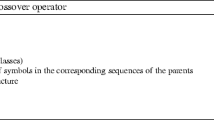Abstract
This research uses Genetic Algorithms (GA) to suggest new dynamic systems based on topological remapping of system constituents. The bondgraph representation of the dynamic system behavior is evolved by the operators encapsulated in the genetic algorithms to meet the specified design criteria. The resultant evolved graph is assembled by designers with schemes to produce design variants. Behavioral transformation and structural transformation are adopted as strategies to generate design variants that extend beyond the scope of parametric design into innovative design. Behavioral transformation involves changes in the structure of the representation graphs, while maintaining the functions. Structural transformation involves changes in the components and the subsystems represented by the graph fragments. GAs are used to implement the operators of the transformation to search the problem-solution space because GAs are very robust search routines. Further, since the goal is to generate many solutions, genetic speciation is used to diverge the search so as to uncover other desirable solutions. The dynamic systems are modeled using bond graphs. Bond graphs provide a unified approach to the analysis, synthesis and evaluation of dynamic engineering systems. Though the scope of this investigation is limited to systems represented by bond graphs, the domain is wide enough to include many interesting applications like pump systems and vibration isolation systems.
Similar content being viewed by others
References
Bracewell R, Sharpe J. A computer aided methodology for the development of conceptual schemes for mixed energy-transforming and real-time information systems. Proc Lancaster Int'l Workshop on Engineering Design, Computer Aided Conceptual Design. 1994, pp 79–94
Breedveld PC, Rosenberg RC, Zhou. Bibliography of bond graph theory and application. J Franklin Institute 1991; 328(5/6): 1067–1109
Carlson S, Pegg T. Genetic operators for catalog design. Advances in Design Automation 1995 Proc. September 17–21 1996, Boston, MA
Chapman CD. Structural topology optimization via the genetic algorithms. MS Thesis, Department of Mechanical Engineering, MIT, 1994
Davis L. (ed.) Handbook of Genetic Algorithms. Van Nostrand Reinhold, New York, 1991
Deb K, Goldberg D. An investigation of niche and species formation in genetic function optimization. Proc Third International Conference on Genetic Algorithms. Morgan Kaufmann, San Mateo CA, 1989, pp 42–50
Finger S, Rinderle JR. Transforming behavioral and physical representations of mechanical designs. Proc First International Workshop in Formal Methods in Design, Manufacturing and Assembly. Colorado Springs, CO, 1990
Gero JS. Design prototypes: a knowledge representation schema for design. AI Magazine 1990: 27–36
Gero JS, Kumar B. Expanding design spaces through new design variables. Design Studies 1993; 14(2): 210–221
Gero JS. Exploration as a basis of creative engineering design. In Khozemeh K. (ed.) Computing in Civil Engineering. ASCE, New York, NY, 1993, pp 1825–1831
Goldberg D. Genetic Algorithms in Search, Optimization, and Machine Learning. Addison-Wesley, Reading, MA, 1989
Harris CM. (ed.) Shock and Vibration Handbook, 3rd ed. McGraw-Hill, New York, NY, 1987
Hoover SP, Rinderle JR. A synthesis strategy for mechanical devices. Research in Engineering Design 1989; 1: 87–103
Karnopp DC, Margolis DL, Rosenberg RC. System Dynamics, A Unified Approach, 2nd ed. John Wiley & Sons, 1990
Margolis DL, Karnopp DC. Analysis and simulation of planar mechanism systems using bond graphs. ASME J Mech Des 1979; 101(2): 187–191
Martens HR, Bell AC. A logical procedure for the construction of bond graphs in systems modeling. J Dynamic Systems, Measurement, and Control 1972; 94(3): 183–188
Nelson FC. Vibration isolation: A review, I. Sinusoidal and random excitations. Shock and Vibration 1994; 1(5): 485–493
Prabhu DR. Synthesis of systems from specifications containing orientations and positions associated with flow variables. Proc 1989 Design Automation Conference, Montreal, Canada, 1989
Parmee IC, Denham MJ, Roberts A. Evolutionary engineering design using the genetic algorithm. Proc ICED '93. The Hague, August 17–19 1993
Ramaswamy R. Computer Tools for Preliminary Parametric Design. MIT Press, Cambridge, MA, 1993
Redfield RC. Bond graphs as a tool in mechanical system conceptual design. Automated Modeling 1992
Rinderle JR, Subramaniam BL. Automated bond graph modeling and simplification to support design. Automated Modeling 1991; 34: 45–68
Rosenberg RC. State-space formulation for bond graph models of multiport systems. Trans ASME Dynamic Systems, Measurement, and Control 1971; 93(1): 35–40
Slocum AH. Precision Machine Design. Prentice-Hall, 1992
Tay FEH. Development of a model for innovative design. Engineering Design and Automation. (Submitted 1996)
Ulrich KT, Seering WP. Function sharing in mechanical design. 7th National Conference on Artificial Intelligence, AAAI-88. Minneapolis, 1988
Ulrich KT, Seering WP. Synthesis of schematic descriptions in mechanical design. Research in Engineering Design 1989; 1(1): 5–18
Wallace DR. A probabilistic specification-based design model: applications to search and environmental computer-aided design. PhD Thesis, Dept of Mechanical Engineering, MIT, 1994
Author information
Authors and Affiliations
Rights and permissions
About this article
Cite this article
Tay, E.H., Flowers, W. & Barrus, J. Automated generation and analysis of dynamic system designs. Research in Engineering Design 10, 15–29 (1998). https://doi.org/10.1007/BF01580267
Issue Date:
DOI: https://doi.org/10.1007/BF01580267




